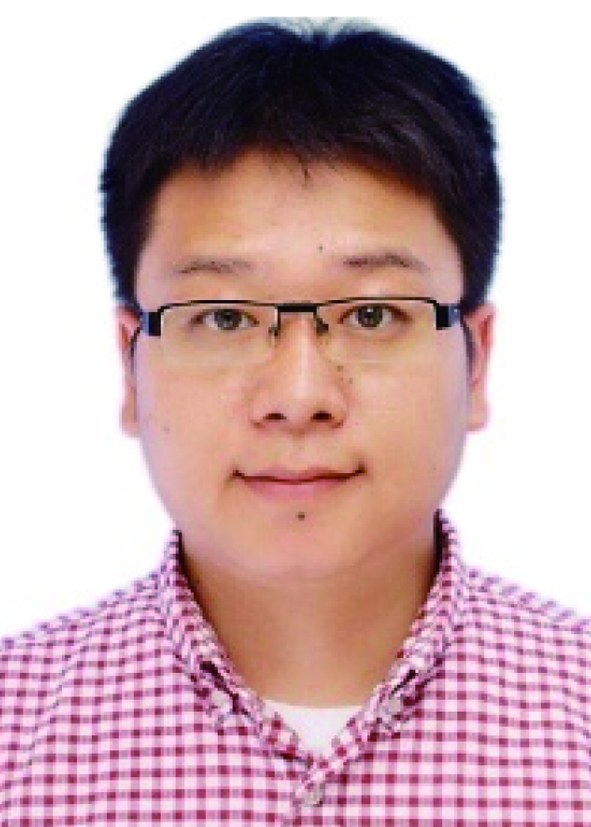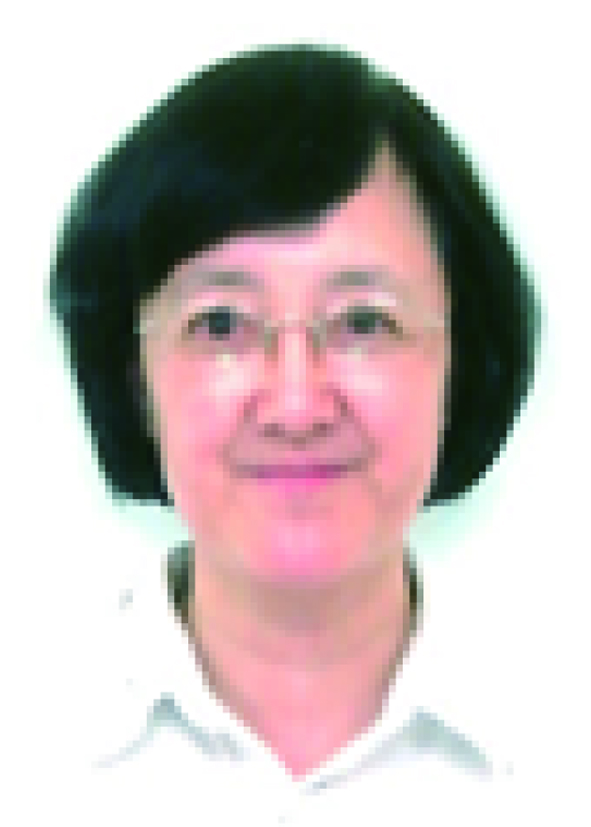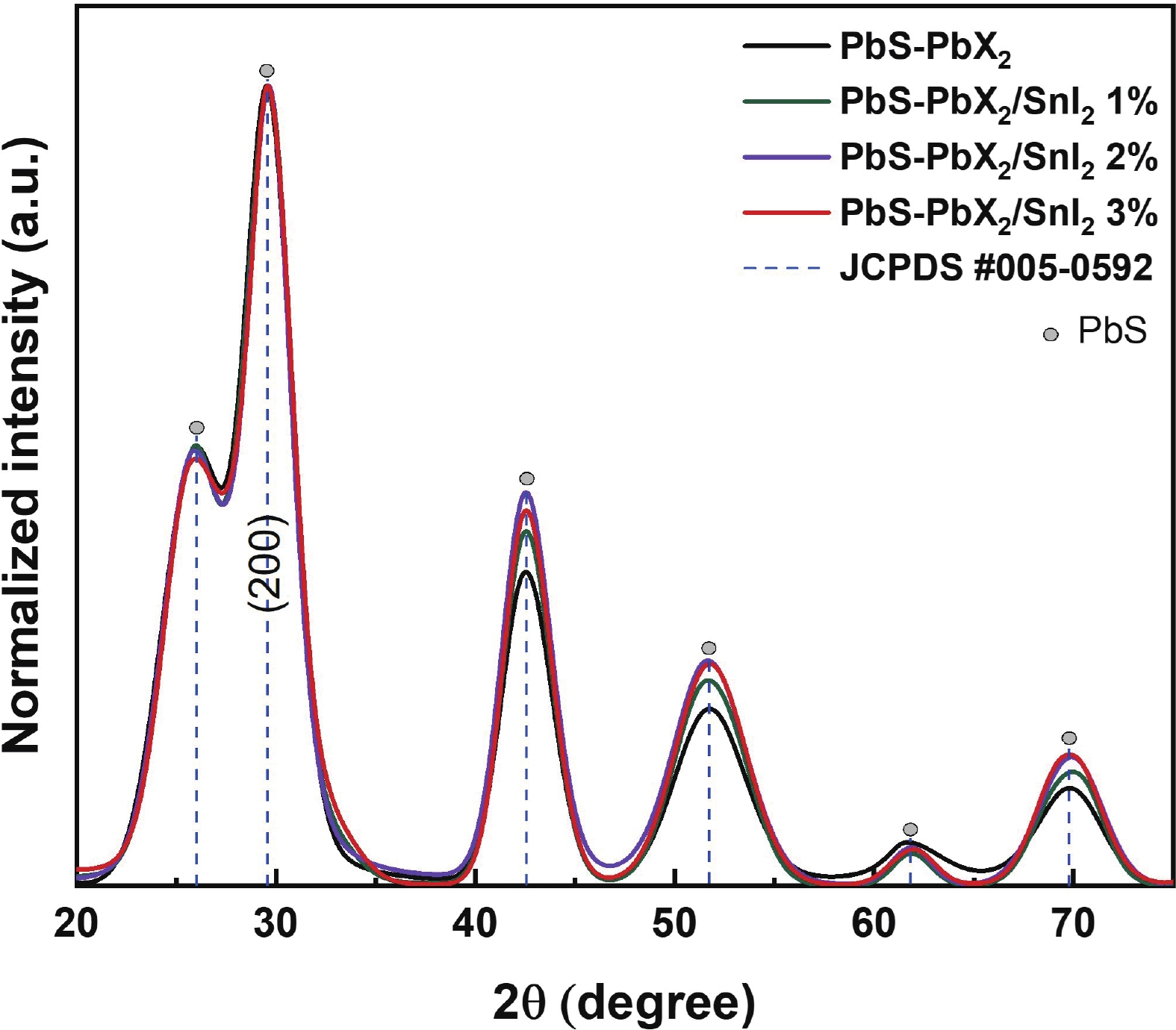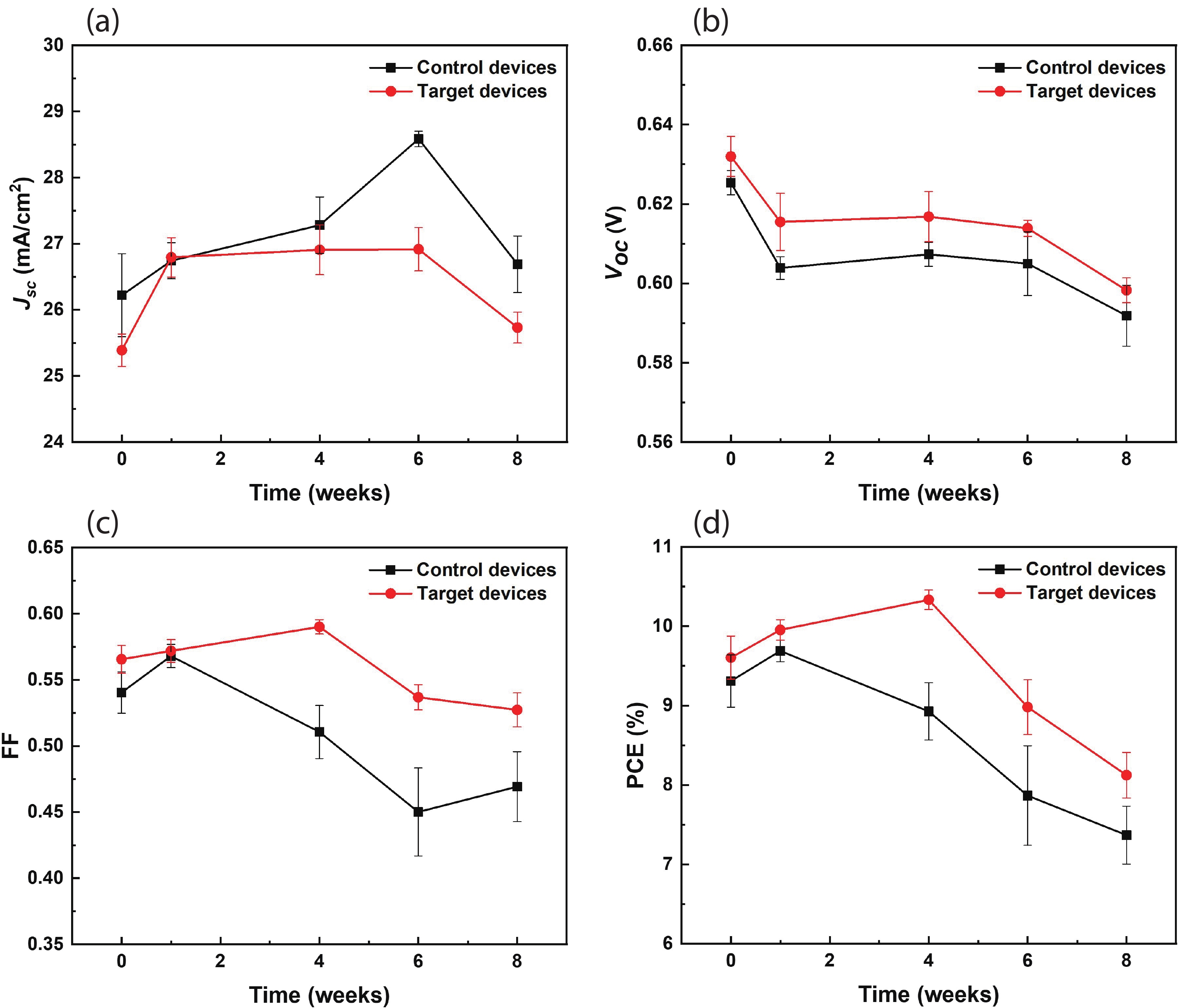| Citation: |
Napasuda Wichaiyo, Yuyao Wei, Chao Ding, Guozheng Shi, Witoon Yindeesuk, Liang Wang, Huān Bì, Jiaqi Liu, Shuzi Hayase, Yusheng Li, Yongge Yang, Qing Shen. Synthesis of p-type PbS quantum dot ink via inorganic ligand exchange in solution for high-efficiency and stable solar cells[J]. Journal of Semiconductors, 2025, 46(4): 042104. doi: 10.1088/1674-4926/25030003
****
N Wichaiyo, Y Y Wei, C Ding, G Z Shi, W Yindeesuk, L Wang, H Bì, J Q Liu, S Hayase, Y S Li, Y G Yang, and Q Shen, Synthesis of p-type PbS quantum dot ink via inorganic ligand exchange in solution for high-efficiency and stable solar cells[J]. J. Semicond., 2025, 46(4), 042104 doi: 10.1088/1674-4926/25030003
|
Synthesis of p-type PbS quantum dot ink via inorganic ligand exchange in solution for high-efficiency and stable solar cells
DOI: 10.1088/1674-4926/25030003
CSTR: 32376.14.1674-4926.25030003
More Information-
Abstract
Traditional p-type colloidal quantum dot (CQD) hole transport layers (HTLs) used in CQD solar cells (CQDSCs) are commonly based on organic ligands exchange and the layer-by-layer (LbL) technique. Nonetheless, the ligand detachment and complex fabrication process introduce surface defects, compromising device stability and efficiency. In this work, we propose a solution-phase ligand exchange (SPLE) method utilizing inorganic ligands to develop stable p-type lead sulfide (PbS) CQD inks for the first time. Various amounts of tin (II) iodide (SnI2) were mixed with lead halide (PbX2; X = I, Br) in the ligand solution. By precisely controlling the SnI₂ concentration, we regulate the transition of PbS QDs from n-type to p-type. PbS CQDSCs were fabricated using two different HTL approaches: one with 1,2-ethanedithiol (EDT)-passivated QDs via the LbL method (control) and another with inorganic ligand-passivated QD ink (target). The target devices achieved a higher power conversion efficiency (PCE) of 10.93%, compared to 9.83% for the control devices. This improvement is attributed to reduced interfacial defects and enhanced carrier mobility. The proposed technique offers an efficient pathway for producing stable p-type PbS CQD inks using inorganic ligands, paving the way for high-performance and flexible CQD-based optoelectronic devices. -
References
[1] Choi M J, García de Arquer F P, Proppe A H, et al. Cascade surface modification of colloidal quantum dot inks enables efficient bulk homojunction photovoltaics. Nat Commun, 2020, 11(1), 103 doi: 10.1038/s41467-019-13437-2[2] Voznyy O, Zhitomirsky D, Stadler P, et al. A charge-orbital balance picture of doping in colloidal quantum dot solids. ACS Nano, 2012, 6(9), 8448 doi: 10.1021/nn303364d[3] Meng L J, Xu Q W, Thakur U K, et al. Unusual surface ligand doping-induced p-type quantum dot solids and their application in solar cells. ACS Appl Mater Interfaces, 2020, 12(48), 53942 doi: 10.1021/acsami.0c15576[4] Crisp R W, Kroupa D M, Marshall A R, et al. Metal halide solid-state surface treatment for high efficiency PbS and PbSe QD solar cells. Sci Rep, 2015, 5, 9945 doi: 10.1038/srep09945[5] Nozik A J. Multiple exciton generation in semiconductor quantum dots. Chem Phys Lett, 2008, 457(1/2/3), 3 doi: 10.1016/j.cplett.2008.03.094[6] Giansante C, Infante I, Fabiano E, et al. "Darker-than-black" PbS quantum dots: Enhancing optical absorption of colloidal semiconductor nanocrystals via short conjugated ligands. J Am Chem Soc, 2015, 137(5), 1875 doi: 10.1021/ja510739q[7] Moreels I, Lambert K, Smeets D, et al. Size-dependent optical properties of colloidal PbS quantum dots. ACS Nano, 2009, 3(10), 3023 doi: 10.1021/nn900863a[8] Zhao H G, Rosei F. Colloidal quantum dots for solar technologies. Chem, 2017, 3(2), 229 doi: 10.1016/j.chempr.2017.07.007[9] Meng L J, Xu Q W, Zhang J W, et al. Colloidal quantum dot materials for next-generation near-infrared optoelectronics. Chem Commun, 2024, 60(9), 1072 doi: 10.1039/D3CC04315K[10] Lin L H, Dong Z H, Wang J, et al. Flexible ultrahigh-resolution quantum-dot light-emitting diodes. Adv Funct Materials, 2024, 34(48), 2408604 doi: 10.1002/adfm.202408604[11] Wang H, Pinna J, Romero D G, et al. PbS quantum dots ink with months-long shelf-lifetime enabling scalable and efficient short-wavelength infrared photodetectors. Adv Mater, 2024, 36(19), 2311526 doi: 10.1002/adma.202311526[12] Wei H L, Ji X Y, Cao J G, et al. High-performance CsPbI3 quantum dot photodetector with a vertical structure based on the Frenkel-Poole emission effect. ACS Nano, 2024, 18(39), 26643 doi: 10.1021/acsnano.4c05111[13] Song H, Yang D, Wang D K, et al. Size-dependent thermal activation emissions in infrared PbS colloidal quantum dots. J Phys Chem C, 2024, 128(23), 9676 doi: 10.1021/acs.jpcc.4c02444[14] Wang C, Wang Y L, Jia Y W, et al. Precursor chemistry enables the surface ligand control of PbS quantum dots for efficient photovoltaics. Adv Sci, 2023, 10(4), e2204655 doi: 10.1002/advs.202204655[15] Ding C, Wang D D, Liu D, et al. Over 15% efficiency PbS quantum-dot solar cells by synergistic effects of three interface engineering: Reducing nonradiative recombination and balancing charge carrier extraction. Adv Energy Mater, 2022, 12(35), 2270148 doi: 10.1002/aenm.202270148[16] Sun B, Johnston A, Xu C, et al. Monolayer perovskite bridges enable strong quantum dot coupling for efficient solar cells. Joule, 2020, 4(7), 1542 doi: 10.1016/j.joule.2020.05.011[17] Wei Y Y, Ding C, Shi G Z, et al. Stronger coupling of quantum dots in hole transport layer through intermediate ligand exchange to enhance the efficiency of PbS quantum dot solar cells. Small Methods, 2024, 8(12), e2400015 doi: 10.1002/smtd.202400015[18] Lan X Z, Masala S, Sargent E H. Charge-extraction strategies for colloidal quantum dot photovoltaics. Nat Mater, 2014, 13(3), 233 doi: 10.1038/nmat3816[19] Liu M X, Che F L, Sun B, et al. Controlled steric hindrance enables efficient ligand exchange for stable, infrared-bandgap quantum dot inks. ACS Energy Lett, 2019, 4(6), 1225 doi: 10.1021/acsenergylett.9b00388[20] Zhidkov I S, Akbulatov A F, Poteryaev A I, et al. The photochemical stability of PbI2 and PbBr2: optical and XPS and DFT studies. Coatings, 2023, 13(4), 784 doi: 10.3390/coatings13040784[21] Wang C, Wu Q, Wang Y L, et al. P-type PbS quantum dot solar ink via hydrogen-bonding modulated solvation for high-efficiency photovoltaics. Adv Funct Materials, 2024, 34(18), 2315365 doi: 10.1002/adfm.202315365[22] Dambhare N V, Sharma A, Mahajan C, et al. Thiocyanate- and thiol-functionalized p-doped quantum dot colloids for the development of bulk homojunction solar cells. Energy Tech, 2022, 10(9), 2200455 doi: 10.1002/ente.202200455[23] Teh Z L, Hu L, Zhang Z L, et al. Enhanced power conversion efficiency via hybrid ligand exchange treatment of p-type PbS quantum dots. ACS Appl Mater Interfaces, 2020, 12(20), 22751 doi: 10.1021/acsami.9b23492[24] Fang D, He F, Xie J L, et al. Calibration of binding energy positions with C1s for XPS results. J Wuhan Univ Technol Mater Sci Ed, 2020, 35(4), 711 doi: 10.1007/s11595-020-2312-7[25] Xiong W T, Tang W D, Zhang G, et al. Controllable p- and n-type behaviours in emissive perovskite semiconductors. Nature, 2024, 633(8029), 344 doi: 10.1038/s41586-024-07792-4[26] Hossain T, Joy S, Draffen K, et al. Oxidation in tin halide perovskites: Influence of acidic and basic additives. ACS Appl Energy Mater, 2023, 6(24), 12334 doi: 10.1021/acsaem.3c02150[27] Yokoyama K, Omata T, Yokoyama S, et al. Ambient aqueous-phase synthesis of highly stable methylammonium tin iodide perovskites using alkali iodides and ascorbic acid. ACS Appl Energy Mater, 2023, 6(21), 11070 doi: 10.1021/acsaem.3c01909[28] Bhardwaj A, Marongiu D, Demontis V, et al. Single crystal Sn-based halide perovskites. Nanomater, 2024, 14(17), 1444 doi: 10.3390/nano14171444 -
Supplements
 Supporting_information.pdf
Supporting_information.pdf

-
Proportional views





 Napasuda Wichaiyo received her BSc (2020) degree and MSc (2022) degree in Applied Physics from King Mongkut's Institute of Technology Ladkrabang, Bangkok, Thailand. She is pursuing a Ph.D. degree in the University of Electro-Communications, Tokyo, Japan currently. Her research focuses on high efficiency PbS quantum dot solar cells by interface engineering.
Napasuda Wichaiyo received her BSc (2020) degree and MSc (2022) degree in Applied Physics from King Mongkut's Institute of Technology Ladkrabang, Bangkok, Thailand. She is pursuing a Ph.D. degree in the University of Electro-Communications, Tokyo, Japan currently. Her research focuses on high efficiency PbS quantum dot solar cells by interface engineering. Yuyao Wei received her BSc (2018) degree in Energy and Power Engineering and MSc (2021) degree in Building Technology Science from Beijing University of Civil Engineering and Architecture, China and a Ph.D (2024) degree in Engineering Science from the University of Electro-Communications, Tokyo, Japan in 2024. She is currently working in Shen's lab in the University of Electro-Communications, Japan. Her research focuses on high efficiency PbS quantum dot solar cells by interface engineering.
Yuyao Wei received her BSc (2018) degree in Energy and Power Engineering and MSc (2021) degree in Building Technology Science from Beijing University of Civil Engineering and Architecture, China and a Ph.D (2024) degree in Engineering Science from the University of Electro-Communications, Tokyo, Japan in 2024. She is currently working in Shen's lab in the University of Electro-Communications, Japan. Her research focuses on high efficiency PbS quantum dot solar cells by interface engineering. Chao Ding received his BSc (2011) and MSc (2014) degrees in Materials Physics and Chemistry from Sichuan University, China and a Ph.D (2018) degree in the Department of Engineering Science from the University of Electro Communications, Japan. Currently, he is an associate professor at the Institute of New Energy and Low-Carbon Technology of Sichuan University. His research interests include development of emerging photovoltaic based materials (colloidal quantum dot and perovskite solar cells); ultrafast spectroscopy study of photophysics in colloidal nanocrystals; carrier dynamics in light harvesting and emitting devices.
Chao Ding received his BSc (2011) and MSc (2014) degrees in Materials Physics and Chemistry from Sichuan University, China and a Ph.D (2018) degree in the Department of Engineering Science from the University of Electro Communications, Japan. Currently, he is an associate professor at the Institute of New Energy and Low-Carbon Technology of Sichuan University. His research interests include development of emerging photovoltaic based materials (colloidal quantum dot and perovskite solar cells); ultrafast spectroscopy study of photophysics in colloidal nanocrystals; carrier dynamics in light harvesting and emitting devices. Qing Shen obtained a bachelor's degree from the School of Physics at Nanjing University and a Ph.D. from the Graduate School of Engineering at the University of Tokyo. After completing her doctorate, she worked as an assistant at the Graduate School of Engineering at the University of Tokyo. She then moved to the University of Electro-Communications, where she is currently a professor. Her research interests include semiconductor nanomaterials and their applications in optoelectronic devices, the study of photoexcited carrier dynamics using time-resolved laser spectroscopy, and fundamental research on novel types of solar cells.
Qing Shen obtained a bachelor's degree from the School of Physics at Nanjing University and a Ph.D. from the Graduate School of Engineering at the University of Tokyo. After completing her doctorate, she worked as an assistant at the Graduate School of Engineering at the University of Tokyo. She then moved to the University of Electro-Communications, where she is currently a professor. Her research interests include semiconductor nanomaterials and their applications in optoelectronic devices, the study of photoexcited carrier dynamics using time-resolved laser spectroscopy, and fundamental research on novel types of solar cells.
 DownLoad:
DownLoad:



















